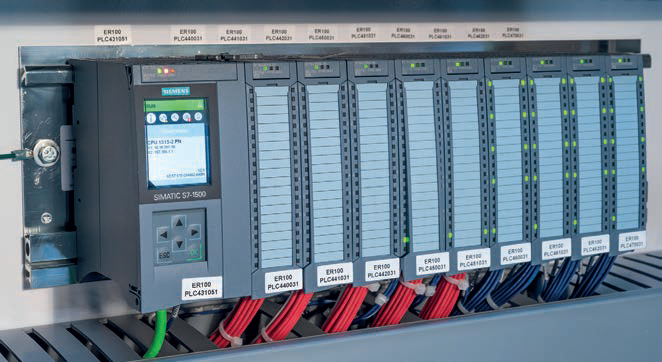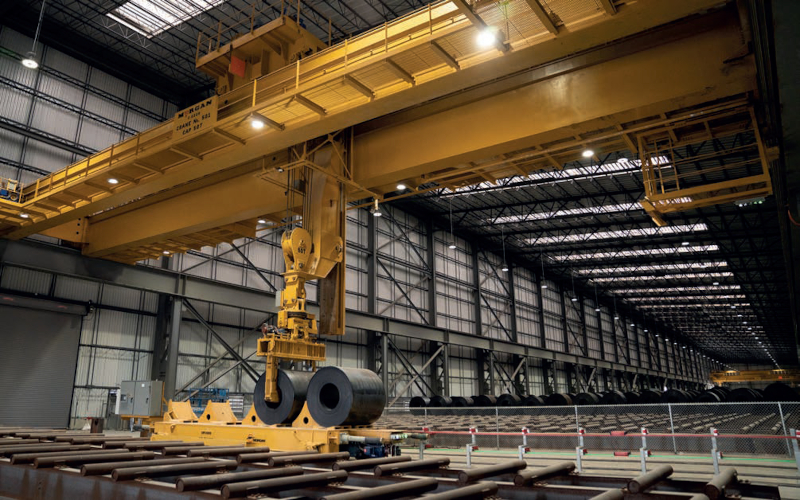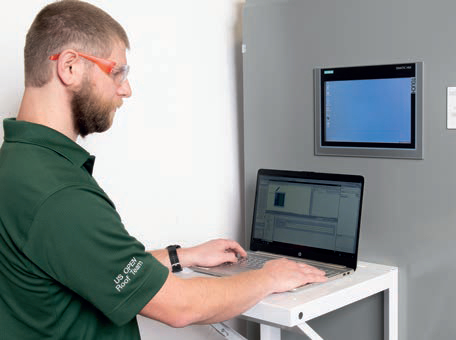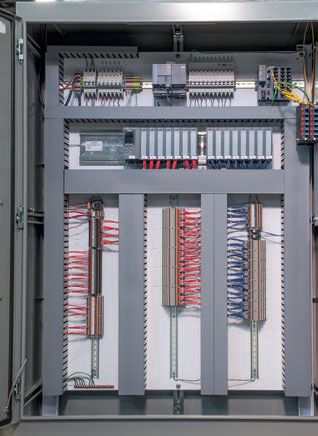Too Hot to Handle
5 May 2022Morgan Automation partners with Siemens to install its motion control and material handling product and software suites for three cranes transferring hot coils at a US Steel Mill
Morgan Automation has partnered with Big River Steel, a US steel mill in Arkansas to devise and implement a fully-automated, non-manned series of three cranes, creating a new approach to coil handling for its rolled-to-order production strategy.
The cranes work with two coil transfer cars accepting hot coils off the walking beam from the hot mill and Morgan turned to Siemens, for its drive, plc, safety I/O, power quality meters, PCs, wireless hardware plus communication software and its TIA Portal for commissioning and monitoring on the project.
“The excellent reliability and performance of the Siemens solution on this project was invaluable in helping us achieve complete operational efficiency and zero downtime during the first six months of operation,” said Mark Sharamitaro, president, Morgan Automation. “When the system is in operation, every movement is carefully orchestrated, and every sensor is continuously monitored and logged with its time stamp. This real-time data collection and evaluation allows the team at Big River Steel to continually identify and improve operational performance.”
The greenfield project involved the handling of approximately 1,000 coils or 30,000 tons of steel a day at the mill.
A typical coil in this yard is approximately 83” OD x 82” W and weighs 28 tons on average. As the mill operates on a “made to order” mindset, there is a dual challenge of handling hot coils from the mill and organizing their staging for shipment by truck, rail or barge, with an additional quadrant on the ground for coils heading via the coil transfer cars provided by Morgan to the Pickling Line Tandem Cold Mill (PLTCM) on the premises.
In the proposed and enclosed coil yard, the walking beam would deliver the coils from the hot mill, then the crane grab would secure the individual coil and place it in the coil transfer car or on a saddle in the appropriate quadrant on the floor. During low production times, the system would defrag the coil assortment into the proper positions to conserve storage space with full tracking in real time.
Each crane has a thermal imaging camera for temp sensing plus a patent-pending laser positioning system. Data tracking is displayed in the mill control room with real time KPI calculations.
The goals for this new Autonomous Coil Yard (ACY) included the indoor facility to reduce rust and corrosion, improved coil handling to meet shipping protocols, reduced energy costs by eliminating lift truck handling and reducing physical distancing of coils, plus faster location of the coils on their saddles for crane handling into the shipment staging areas.
Critical overall was the safety of the personnel, so a system of nine remote I/O cabinets and 21 safety gates were implemented. Integration of the entire operation was handled by the proprietary Morgan CEPHAS logistic management system handled by mill personnel via a virtual private network (VPN).
“We were bringing our established CEPHAS warehouse management system to this challenge and seeking to marry it to a single user interface, driven by the rules established by our customer, so there’s essentially a single bucket of data on each coil. In that “bucket” are all the physical characteristics and temperature of the coil plus the determined location for placement. All this data is transmitted through a series of Siemens Sinamics drive modules, Simatic PLCs and the Sinema network monitoring server, complemented by WinCC V16 supervisory control for monitoring over long distances. In addition, Siemens offered its Scalance wireless suite of ethernet switches and access points to communicate the ring topology and VLAN data to the mill control room personnel,” said Sharamitaro.
Sharamitaro said Morgan tested the components beyond their published ratings, so his team knew they would perform in this application, especially at the moment when the crane would pick up a hot coil and hoist it up near the trolley with the controls onboard.
As each coil is grabbed, a full battery of sensors, switches, I/O power supply, drives, PLCs and wireless communication sends information from the crane trolley directly to the control house. The three 190 ton cranes are fully synchronized for handling the incoming coils from the hot mill plus the placement of the coils in the transfer cars and staging lines.
The information feeds the CEPHAS system of Morgan Automation, which makes the algorithmic determinations for each coil, based on predetermined parameters set by the mill.
Leading the project for Siemens were Roland Najbar, business development manager, and Rick Ludlow, account manager, both focused in the crane industry. “Once we had the full requirements from Morgan, we went to work assembling our motion control and material handling product and software suites to accommodate them. The need for fully unattended operation and wireless communication in the mill presented some challenges, but our team responded with a combination of time-tested drive, wireless and PLC products as well as some newer offerings such as the Sinema network monitoring system,” said Najbar.
Another key component in the Siemens solution was the Sinamics S120 Smart Line Module for crane applications, which features onboard regenerative drive. This feature takes the excess motor power from a crane hoist, for example, during descent and feeds it to another component in the system or back to the grid for trackable energy savings to the customer.



